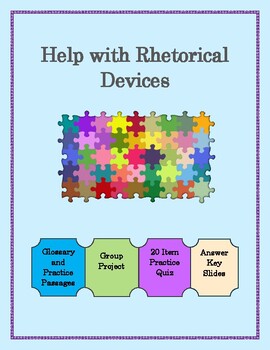Practice & Assessment for Rhetorical Devices - AP Language & Comp. Help
- Zip
Description
This resource provides an introduction or additional practice for high school students as they learn how to recognize a writer’s use of rhetorical devices. A detailed glossary, practice passages, group project, quiz, and review slides will help build skills needed to comprehend and analyze nonfiction. These activities can be especially helpful in increasing reading and writing ability in AP Language and Composition or AP Literature classes.
The glossary includes 33 rhetorical devices with detailed definitions and examples. Five short passages provide practice at identifying the devices in context. There is an answer key for this activity.
Students can also practice using these devices in a group project. Detailed instructions direct students to create and present skits that integrate several rhetorical devices. The planning is great practice and the presentations are a fun review for the class. A printable set of instructions with suggestions for formats organizes the assignment. The process takes about a week to complete from planning to presenting. A rubric for assessment is also provided.
The quiz includes a word bank with a mix of twenty statements and quotes. The items are fairly basic and can be useful as practice, review, or assessment. Corresponding slides provide an answer key for each test item and a useful whole class review.
Contents List:
Three-page glossary with definitions and examples (PDF)
Five short practice passages (PDF)
Answer key for each passage (PDF)
Group project (Editable)
Instruction page
Planning form to turn in
Rubric
20 item quiz (PDF)
20 slides- answer key and review (PDF)





